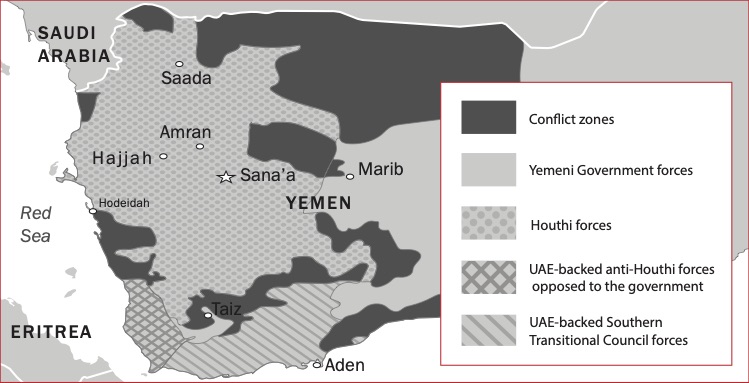6. Armed conflict and peace processes in the Middle East and North Africa
Overview, Ian Davis [PDF]
I. Key general developments in the region, Ian Davis [PDF]
II. Armed conflict and peace processes in Iraq, Syria and Turkey, Ian Davis and Shivan Fazil [PDF]
III. The Israeli–Palestinian conflict and peace process, Ian Davis [PDF]
IV. Armed conflict and peace processes in North Africa, Ian Davis [PDF]
V. Armed conflict and peace processes in Yemen, Ian Davis [PDF]
There were seven states with active armed conflicts in the Middle East and North Africa (MENA) in 2020 (the same number as in 2017–19): Egypt (low-intensity, subnational armed conflict), Iraq (internationalized civil war), Israel (low-intensity, extrastate armed conflict), Libya (internationalized civil war), Syria (internationalized civil war), Turkey (low-intensity, extrastate and subnational armed conflict) and Yemen (major internationalized civil war). All the armed conflicts had fewer fatalities than in 2019, and total conflict-related fatalities in the region have reduced by almost 70 per cent since 2017. With conflict-related fatalities in Syria dropping below 10 000 in 2020, the war in Yemen remained the region’s only major armed conflict. Many of these conflicts were interconnected and involved regional and international powers, as well as numerous non-state actors.
A ceasefire in Idlib province in Syria in March 2020 and a nationwide ceasefire agreed in Libya in October 2020 suggested both of those conflicts might be open to some form of resolution soon. However, in Yemen implementation of the 2018 Stockholm Agreement remained stalled.
The Covid-19 pandemic appears to have had minimal impact on the region’s armed conflicts, although it clearly added another layer of complexity to the existing humanitarian challenges. Anti-government protests occurred throughout the region, with mass protests in Algeria, Iraq and Lebanon, and sporadic protests in Egypt, Iran, Israel, Jordan, Morocco, the Palestinian territories and Tunisia. In addition, tensions between Iran and the United States again threatened to escalate into a more serious interstate military conflict.
There were 14 multilateral peace operations in the MENA region in 2020—the same number as in 2019.
Complex and interlinked armed conflicts in Iraq, Syria and Turkey
During 2020 the government of President Bashar al-Assad continued to consolidate its hold in Syria, with armed opposition focused on two areas: Idlib province in the north-west, and regions in the north-east partially controlled by Kurds. The March ceasefire in Idlib province led to a further reduction in large-scale hostilities.
In 2020 Iraq remained a fragile, largely post-conflict state with weak institutions and growing protests. Iran remained an influential presence in Iraq (as well as Syria), and Iranian–US tensions spilled over into Iraq. Turkey intensified its military operations in northern Iraq, and the protracted armed conflict in the south-east of Turkey also continued.
The Idlib ceasefire brokered by Russia and Turkey cemented their roles as key power brokers in Syria, while US influence continued to wane.
North Africa and the armed conflict in Libya
North Africa is undergoing a convergence of crises, with negative spillover onto the stability of neighbouring states in the eastern Mediterranean and sub-Saharan Africa. The 40-year territorial dispute over the Sahrawi Arab Democratic Republic (Western Sahara) between Morocco and the Popular Front for the Liberation of Saguia el Hamra and Río de Oro (Polisario Front) erupted again towards the end of the year, while Egypt’s low-level Sinai insurgency continued in 2020 with no sign of an end or a decisive outcome.
The deepening roles of Egypt, Russia and Turkey in the civil war in Libya complicated peace efforts and increased the risk of a direct military confrontation between Turkish and Egyptian or Russian armed forces supporting opposing sides in the armed conflict. An internationally backed ceasefire in Libya in October 2020 offered new grounds for optimism.
Areas of control and conflict in Yemen, May 2020

Note: The boundaries used in this map do not imply any endorsement or acceptance by SIPRI.
Yemen
Despite attempts mediated by the United Nations to end the civil war in Yemen, the armed conflict there continued throughout the year, further exacerbating one of the world’s worst humanitarian crises. A UN panel of experts concluded that the pattern of armed conflicts in 2020 had predominantly shifted to economic drivers, while in October the UN warned that the country was on the brink of a catastrophic food security crisis. At the end of the year, the Houthis continued to dominate the Yemeni political, economic and military landscape, controlling one-third of the country’s territory and two-thirds of the population. Agreeing a lasting political settlement remains fraught with difficulty as the Houthis are unlikely to stop fighting until they fully control Marib, Hodeidah and Taiz.